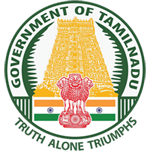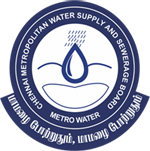



Chennai Metropolitan Water Supply and Sewerage Board
Water Quality Concerns
Minimum and Desirable constituents to be determined for common uses of water
| Domestic | Public supply | Irrigation | General Industrial Supply | |
| Suggested minimum analysis | Iron Hardness Detergents Fluorides |
Silica Iron Manganese Magnesium Bicarbonate Sulphate Chloride, Fluoride, Nitrate, Dissolved solids pH, Colour, Turbidity, Phenols Detergents Heavy metals |
Calcium Magnesium Sodium Bicarbonate Boron Spec.Conductance |
Iron, Magnesium Sodium Bicarbonate Hardness Dis.solids ph Temperature |
| Desirable additional analysis | Manganese Bicarbonate Sulphate Chloride Nitrate Diss.solids, pH |
Lithium Sulphate Chloride Diss.solids |
Silica Chloride Colour, Turbidity Sulphide |
As per World Health Organisation (WHO) and Indian Standards, the permissible limit of various constitutents in the potable water is as follows:
Standards and Criteria for drinking water in mg/I
| Substance of Property | World Health Organisation | Public Health Committee of Govt. of India | ||
| Maximum acceptance | Maximum Allowable | Permissive | Excessive | |
| Physical | Manganese Bicarbonate Sulphate Chloride Nitrate Diss.solids, pH |
Lithium Sulphate Chloride Diss.solids |
Silica Chloride Colour, Turbidity Sulphide |
|
| Turbidity (Units) | 5 | 25 | 5 | 25 |
| Colour (Platinum Cobalt Scale) | 5 | 50 | 5 | 25 |
| Taste and Odour | Unobjectionble | - | Unobjectionble | - |
| Chemical | ||||
| pH range | 7- 8.5 | - | 7- 8.5 | - |
| Total Solids | 500 | 1500 | 500 | 1500 |
| Total hardness as CaCo3 | - | - | 300 | 600 |
| Calcium | 75 | 200 | 75 | 200 |
| Magnesium | 50 | 150 | 50 | 150 |
| Iron | 0.30 | 1.00 | 0.30 | 1.00 |
| Manganese | 0.10 | 1.50 | 0.10 | 1.50 |
| Copper | 1.00 | 1.50 | 1.00 | 1.50 |
| Zinc | 5 | 15 | 5 | 15 |
| Chloride | 200 | 600 | 250 | 1000 |
| Sulphate | 200 | 400 | 250 | 400 |
| Magnesium + Sodium Sulphate | 500 | 1000 | - | - |
| Phenolic substances (as phenol) | 0.001 | 0.002 | 0.001 | 0.002 |
| Flouride | - | 1.5 | 1.0 | 2.0 |
| Nitrate Nitrogen | - | 45 | 20 | 50 |
| Nitrite Nitrogen | - | - | - | - |
| Carbon Chloroform extract (CCE-Organic Pollutants) | 0.20 | 0.50 | - | - |
| Alkyl benzoyal sulphonates (ABS Sulphactants (ms/l) | 0.50 | 1.00 | - | - |
| Toxic: Cadmium | - | 0.01 | - | - |
| Chromium (as Hexavelent) | - | 0.05 | - | 0.01 |
| Cynaide | - | 0.20 | - | 0.01 |
| Arsenic | - | 0.05 | - | 0.20 |
| Lead | - | 0.05 | - | 0.10 |
| Selenium | - | 0.01 | - | 0.05 |
The rain water is the purest form of water. Therefore, the rain water collected from neat and clean surfaces like terrace can be directly used. It is advisable to filter and boil the water so collected as when it runs on the surface source dust particles may come with it.
Soil Lithology and Rain Water Harvesting

The quantum of the rain water which can be harvested are recharged into the underground aquifer depends on the nature of the soil. The design of the RWH structures depends on the soil nature. If the soil is having good permeability, water will be recharged fast but if the permeability of the soil is poor, the water recharge will be very slow. For example, the permeability of sandy soil is good and of clay is poor. Therefore, it can be seen that the water drains/seeps underground very fast while in clay it is very slow.
Therefore the RWH structure is to be designed in such a way that through recharge pits/bores the water is taken upto sandy strata so that the rate of percolation is fast.
The map below indicates various soil zones in Chennai city and the desired depth of the RWH structures.
Details of favourable aquifer zones
| SI.NO | Colour | Selected Areas | Water level during summer in 'm' | Depth of the aquifer in 'm' | Saturated thickness in 'm' | Recharge zone in 'm' |
| 1. | Blue | Secretariat, Port,Chepauk, Triplicane,Santhome Seashore, Karpagam Garden, M.R.C. Nagar | 3 | 10 | 7 | 3 |
| Egmore, BesantNagar SasthriNagar, Karpagam Avenue, Thiruvanmiyur | 4 | 10 | 6 | 4 | ||
| Ekkattuthangal | 6 | 10 | 6 | 4 | ||
| 2. | Orange | ParrysCorner, Mint,Sevenwells, Kothaval Chavadi, VallalarNagar, ParkTown, Sowcarpet, Mylapore, Mandaiveli, Alwarpet, RajaAnnamalapuram, Pattinapakkam | 6 | 5 | 9 | 6 |
| 3. | Yellow | Nungambakkam(Lakearea), T.Nagar, West CITNagar, Teynampet, Gopalapuram, Royapettah, ThousandLights, KK Nagar | 9 | 15 | 6 | 9 |
| Adayar,GandhiNagar, IndiraNagar, Kasthuribha Nagar | 8 | 15 | 7 | 8 | ||
| 4. | Light Red | Ayanavaram, ICFQuarters, Kilpauk, Kilpauk Garden, Shenoy Nagar(East) | 7 | 20 | 13 | 7 |
| Anna Nagar, Anna Nagar (West), Shenoy Nagar (West) | 12 | 20 | 18 | 12 | ||
| Koyambedu | 14 | 30 | 16 | 14 | ||
| 5. | Green | Perambur | 7 | 30 | 23 | 7 |
| Alandur,Guindy, Chinnamalai, Tharamani, St.Thomas Mount | Hard Rock |
The following table shows the porosity, specific yield and permeability characteristics of soil formation.
Representative Values for Selected Soil Formation
| SI.NO | Description | Porosity Percent | Specific Yield Percent | Permeability gallon per day/sq.ft. |
| 1. | Clay | 45 - 55 | 1 - 10 | 0.011 - 2.0 |
| 2. | Sand | 35 - 40 | 10 - 30 | 100 - 3000 |
| 3. | Gravel | 30 - 40 | 15 - 30 | 1000 - 15000 |
| 4. | Sand and Gravel | 20 - 35 | 15 - 25 | 200 - 5000 |
| 5. | Sandstone | 10 - 20 | 5 - 10 | 0.1 - 50 |
| 6. | Shale | 1 - 10 | 0.5 - 5 | 0.00001 - 0.1 |